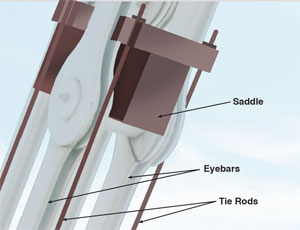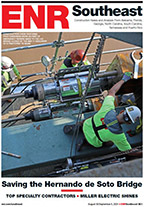California Dept. of Transportation delayed opening of the San Francisco-Oakland Bay Bridge until federal inspectors sign off on the second bridge repair since Labor Day. The transportation corridor, which carries an estimated 280,000 cars per day, closed Tuesday evening after a steel bar cracked during a windy afternoon commute, dropping a 5,000-lb crossbeam and steel connectors into traffic. The incident caused a non-injury accident and an enormous traffic jam. Caltrans officials said they were doing all they could to open before the Monday morning commute, but were putting safety first.

The pieces that fell were part of an emergency fix by Sacramento-based bridge-builder C.C. Myers Inc. over Labor Day weekend after an inspection unrelated to the company�s installation of a new onramp revealed a crack in a steel structural eyebeam in the cantilevered eastern span. Caltrans worked with contractors fabricate a steel saddle brace to wrap around the cracked eyebar, redistributing tension away from the damaged area and linking it with tie rods to a lower saddle.
In the Spetember repair, crews worked nonstop for 70 hours to complete the fix before the Tuesday morning commute. The contractor was heralded for the quick work, but Federal Highway Administration inspectors never checked the repairs.
Caltrans inspectors did continue to monitor the fix and a week-and-a-half before the Oct. 27 failure noted vibration on the support bars. The agency did not consider that the phenomenon posed an imminent problem, according to Dale Bonner, California secretary of Business, Transportation and Housing. “I want to stress that while a cracked eyebar can lead to catastrophic failure, we are not anywhere near that,” he said. A piece of the brace—not the eyebar itself—is what failed, and the crack is not migrating, he added.
To fix the repair, Caltrans is working with another bridge contractor, North Highlands, Calif.-based MCM Construction Inc., which is working on the Oakland touchdown portion of the new bridge and happened to be near the scene on Tuesday evening. Caltrans is using an enhanced version of the Labor Day fix that focuses on limiting vibration. Engineers hope to limit the fatigue engineers that they suspect caused the failure.
All four steel support rods will be replaced. Damping devices will be installed to keep bolts from moving. Additionally, welders gouged out the connecting welds and deepened them to structural welds.
MCM Construction is also adding straps to hold the four new tie bars to the eyebar. “Tying off the rods will ensure that if there is a failure, pieces won�t fall down,” said Caltrans spokesman Bart Ney.
Contractors are custom grinding any areas where steel could potentially rub against steel to avoid fatigue. Once the rods are back in place, tensioning could take three hours and then the repair will be tested by third-party inspectors. “We will give inspectors all the time they need to test the repairs,” said Bonner.
This time, the replacement pieces were fabricated in Sacramento and trucked to the site. In the previous fix, the saddle was dramatically flown in from Arizona and given a police escort from the airport.
Work was delayed during the week because of safety issues as high winds of 50 mph limited loads on equipment, said Ed Puchi, MCM Construction treasurer.
The result will be a “temporary fix” intended to hold the 73-year-old bridge together until the replacement bridge is complete in 2013.
Bonner said engineers considered replacing the eyebar, but the process would take many months “and may not solve the problem.”
Between now and then, Caltrans plans to increase inspections from every two years to every three months. Additionally, Caltrans plans to close two lanes each Saturday for inspections.
Meanwhile, the damaged pieces from the Labor Day fix will be inspected by a metallurgist for testing to to determine the cause of the failure.
Dan Baker, project manager for C.C. Myers, which installed the original fix and is still working on portions of the new bridge project, said his company is not responsible for the failure because Caltrans approved the design.
Ney said the cost of the original fix was less than $2 million and came from emergency funds. He said the current project would probably fall under the same funding mechanism with the same $3 million limit.
Ney said it is unlikely that Caltrans will seek reimbursement from C.C. Myers for the failure. “We are very happy with the performance of both contractors,” Ney said.


Post a comment to this article
Report Abusive Comment